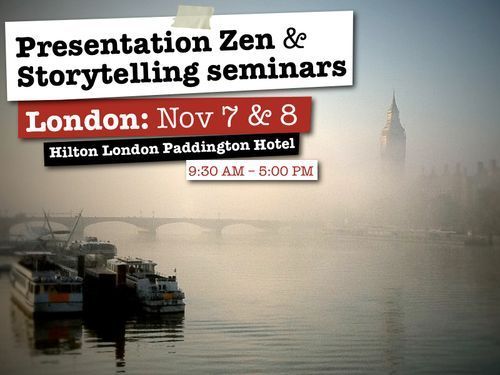Garr Reynolds's Blog, page 13
January 28, 2013
Lucas, Scorsese: On the need for visual literacy
 A professional or student in the 21st century needs to have a good degree of multimedia literacy. The term multimedia literacy and visual literacy encompass many things and borrow from many disciplines. However, for at least a generation or more when people speak of the need for multimedia literacy (they may call it different things) they very often focus on the high-tech tools of the day. This is especially true in education. But the tools of the day are for the most part ephemeral. But an understanding of the principles and techniques and "rules" found in the broad field of visual communication are the thing of real and lasting value. Hardware and software are important, of course, but what's of much greater value is the software between one's ears.
A professional or student in the 21st century needs to have a good degree of multimedia literacy. The term multimedia literacy and visual literacy encompass many things and borrow from many disciplines. However, for at least a generation or more when people speak of the need for multimedia literacy (they may call it different things) they very often focus on the high-tech tools of the day. This is especially true in education. But the tools of the day are for the most part ephemeral. But an understanding of the principles and techniques and "rules" found in the broad field of visual communication are the thing of real and lasting value. Hardware and software are important, of course, but what's of much greater value is the software between one's ears.
Part of multimedia literacy includes a theoretical and practical understanding of the principles and techniques found in graphic design and other forms of visual communication including visual storytelling mediums such as filmmaking or cinema. Media such as video (or call it film, motion pictures, etc.) is extremely powerful. We have known this for at least one hundred years. Motion picture is a valuable tool for telling a story or pitching a product or explaining a process, and so on. And yet visual communication in all its various forms, just like the written word, can be used for good or for bad. Today we find ourselves, however, with a population of adults who are largely ignorant about the power of visual communication and multimedia. Yes, they are surronded by it, they are using it, and they are certainly influenced by it. But the danger is that people do not know that they are influenced by it, or if they have a suspicion that they are, they are not sure how or to what degree. Now, this influence â many may call it manipulation â can be either good or bad, but there is no denying that marketers, advertisers, governments, etc. are attempting to tell visual stories to create a change in the viewer. Many of these stories may be true and sincere. But whether the intent is good or bad, should not an educated person understand the difference?
Below, in separate interviews, two legendary American filmmakers â George Lucas and Martin Scorsese â are very direct in their assertions that visual literacy is crucial for people in today's world and that it should be both more highly valued by educators and taught in schools.
George Lucas on Teaching Visual Literacy and Communications
George Lucas says that visual communication or multimedia literacy should be an integral part of teaching and learning in schools instead of relegated to the artsy peripheral of formal education. Lucas says that what we typically call "the arts" should also be in the regular communication classes were students learn practical applications of graphics, music, various visual arts, and language to tell a story, to sell an idea, to persuade, to question, and so on. Watch video below.
"It's a different way of teaching in the sense that English classes should broaden themselves...and be renamed communication, it's a communication class. You learn how to write, but you also learn graphics...take graphics out of the art department. Take [the art of] cinema and put it into schools...."
                                                                            â George Lucas
Martin Scorsese on the Importance of Visual Literacy
In this 10 minute interview Scorsese comments on visual literacy, cinematic storytelling, violence in flim, and on teaching the story of movies. He begins by recalling his childhood and about being influenced by film and TV and how those mediums led to his discovery of "a different kind of literacy," that is, visual literacy. Watch the interview below.
"[Young people] need to know how ideas and emotions are expressed through a visual form. We have to begin to teach younger people how to use this very powerful tool...because we know the image can be so strong, not only for good use, but for bad use. Film is very powerfulâimages are very powerfulâand we need to teach younger people how to use them....or at least how to interpret them."Â
                                                                            â Martin Scorsese
H/T to Edutopia. A great resource.
Â



January 27, 2013
The storytelling imperative: Make them care!
 Pixar Studios filmmaker Andrew Stanton gave a good TED talk about a year ago where he states that one of the key aims of any good story is that it must make the audience care. "Make me care," he says. If you research the advice of famous directors and screenwriters of today and of years gone by you will find this is a common refrain: You have go to make the audience care. Presentations in all their many forms are never just about transferring information alone. We are emotional beings, like it or not, and to connect and engage people to the degree that they will care enough to listen to you, you have to evoke in them some kind of emotion. The TED talk below is well worth watching; the storytelling lessons in this short talk are many.
Pixar Studios filmmaker Andrew Stanton gave a good TED talk about a year ago where he states that one of the key aims of any good story is that it must make the audience care. "Make me care," he says. If you research the advice of famous directors and screenwriters of today and of years gone by you will find this is a common refrain: You have go to make the audience care. Presentations in all their many forms are never just about transferring information alone. We are emotional beings, like it or not, and to connect and engage people to the degree that they will care enough to listen to you, you have to evoke in them some kind of emotion. The TED talk below is well worth watching; the storytelling lessons in this short talk are many.
On the TED stage Stanton does a great job of getting the audience's attention and engages them immediately with a relevant short story in the form of a joke, a joke that gets a big laugh (strong emotional connection). Then he transitions quickly into the first part of his talk. "Storytelling -- (pauses as audience laughs again) -- is joke telling," Stanton says. " We all love stories. We're born for them. Stories affirm who we are. We all want affirmations that our lives have meaning. And nothing does a greater affirmation than when we connect through stories. It can cross the barriers of time, past, present and future, and allow us to experience the similarities between ourselves and through others, real and imagined."
Below I highlight some of the more salient points Stanton makes concerning story.
 ⢠Make the audience care.
The greatest story commandment of all says Stanton is: "Make me care. Pleaseâemotionally, intellectually, aesthetically â just make me care." But how to make the audience care? This is the most fundamental question of all. There is no single answer, but all the story tips Stanton touches on in his talk go some of the way toward answering this important question. Obviously one important aspect is having empathy for your audience and trying to craft your story and design your content always with the audience in mind.
⢠Make a promise from the beginning.
Very early on you need to get the audience to believe that this story is going to go somewhere, that this will be worth their time. "A well told promise," says Stanton, " is like a pebble being pulled back in a slingshot and propels you forward through the story to the end."
⢠Make 'em work for it.
You don't have to beat people over the head with your message, nor do you need to always make your message painfully obvious. This is not about being vague or unclear, but it is about letting the audience work on their own a little to figure things out. "... the audience actually wants to work for their meal," Stanton says. "They just don't want to know that they're doing that. That's your job as a storyteller, is to hide the fact that you're making them work for their meal. We're born problem solvers. We're compelled to deduce and to deduct, because that's what we do in real life. It's this well-organized absence of information that draws us in." As Stanton says, don't give them 4, give them 2+2 and let them figure it out.
⢠Story is about change. No change, no story.
"We're all learning all the time. And that's why change is fundamental in story," says Stanton. "If things go static, stories die, because life is never static." Anytime we get on a stage to speak we are talking about change. I think of change in two ways. First, the content of every good presentation or story addresses a change or some kind. Second, an effective presentation or a story told well will create a change in the audience. Sometimes this can be a big change and sometimes it is quite small. Too often, though, the only change the presenter creates in the audience is the change from wakefulness to sleep.
Construct anticipation in your story.
In a great story (or presentation) the audience wants to know what happens next. And more than that, Stanton says, the audience will want to know how it all concludes. In an explanatory narrative a series of actions can establish a narrative flow, and even though this may lack the high degree of tension that you can get with a protagonist struggling with a complication, the sense of journey that is created is something close to anticipation of what comes next. Stanton quotes British playwright, William Archer: "Drama is anticipation mingled with uncertainty."
⢠Have a clear theme.
"A strong theme is always running through a well-told story," Stanton says. The theme is often not stated directly in the story but it is the essence or the core idea at the root of the story. Robert McKee refers to this core idea as the "Controlling Idea." If you have a clear sense of your theme or controlling idea, this keeps you from trying to throw too many ideas into one story. For example, McKee says in the book Story that the controlling idea of the movie Groundhog Day is "Happiness fills our lives when we learn to love unconditionally."
⢠Stimulate a sense of wonder
"The best stories infuse wonder," Stanton says. Everything depends on the context of the presentation, but in most cases a good presentation is a mix of logic, data, emotion, and inspiration. We are usually OK with the logic and data part, but fail on the emotional and inspirational end. Certainly leaders and educators need to infuse a bit of wonder into their talks that inspire people to make a change. A good presentation should not end when the speaker sits down or the class comes to an end.
⢠Look inside yourself
Where do you find material for storytelling? Draw from your experiences and look inside yourself. Stanton said that this was the first story lesson he ever learned. "Use what you know. Draw from it. It doesn't always mean plot or fact. It means capturing a truth from your experiencing it, expressing values you personally feel deep down in your core."



January 15, 2013
13 great books to help you succeed, create, & communicate better in 2013
 Recently I read legendary filmmaker Akira Kurosawa's autobiography. One of the many things from his book that resonated with me was his strong belief that voracious reading was a key to his creativity. "I've forgotten who it was that said creation is memory," kurosawa said. "My own experiences and the various things I have read remain in my memory and become the basis upon which I create something new. I couldnât do it out of nothing. For this reason, since the time I was a young man I have always kept a notebook handy when I read a bookâ¦. I have stacks and stacks of these notebooks, and when I go off to write a script, these are what I read. Somewhere they always provide me with a point of breakthrough." Kurosawa's advice to aspiring filmmakers is that they must first become solid screenwriters, and to do this he said, "You must read thoroughly, to the point where you can grasp all these things." Kurosawa was a film director, but he was foremost a storyteller. Now, you may not aspire to make movies, but if you are trying to do good creative work of any kind, the ability to identify and share your ideas through different communication channels in ways that connect and engage is key. In other words, you are a storyteller too.
Recently I read legendary filmmaker Akira Kurosawa's autobiography. One of the many things from his book that resonated with me was his strong belief that voracious reading was a key to his creativity. "I've forgotten who it was that said creation is memory," kurosawa said. "My own experiences and the various things I have read remain in my memory and become the basis upon which I create something new. I couldnât do it out of nothing. For this reason, since the time I was a young man I have always kept a notebook handy when I read a bookâ¦. I have stacks and stacks of these notebooks, and when I go off to write a script, these are what I read. Somewhere they always provide me with a point of breakthrough." Kurosawa's advice to aspiring filmmakers is that they must first become solid screenwriters, and to do this he said, "You must read thoroughly, to the point where you can grasp all these things." Kurosawa was a film director, but he was foremost a storyteller. Now, you may not aspire to make movies, but if you are trying to do good creative work of any kind, the ability to identify and share your ideas through different communication channels in ways that connect and engage is key. In other words, you are a storyteller too. Below are thirteen booksâmost of them quite newâthat I have read recently which may appeal to professionals and students who desire making a bigger splash in the world or in their local communities by sharing their ideas with more clarity and lasting impact. It is not an exhaustive list, but it's a start.
(1) The Impact Equation: Are You Making Things Happen
or Just Making Noise?
  by Chris
by Chris
Brogan and Julien Smith
Your ideas can change the world, at least in a small way (and sometimes in a very big way). In the author's own words, this book is "about getting a larger audience to see and act
upon your ideas and learning how to build a community around that
experience to take it all to an even higher level." We are all "media creators" they say and this book is about helping you get a larger audience to engage with and how to build a community to move your ideas forward. Really good presentation and communication tips in here as well.
(2) To Sell Is Human: The Surprising Truth About Moving Others
  by Daniel Pink
by Daniel Pink
The author of A Whole New Mind and Drive hits the nail on the head (again) with this one. No matter what our profession, most of us are in the business of selling our ideas. As with his other books Pink touches just a bit on the science of his advice and offers practical examples and strategies. There is even a chapter on pitching and the six successors of the elevator pitch and how and when to deploy them.
(3) The Icarus Deception: How High Will You Fly?
 by Seth Godin
by Seth Godin
If you need a little inspiration and motivation, this may be the book for you. If you are already a fan of Seth Godin and have read all his other books and follow his blog, there may not be too much new (but still worth it for SG fans). If you are not so familair with Seth's work, then I think you may find this book especially valuable. There is no (longer) comfort in conformity and playing safe. A good, quick, inspiring read. (A video by Seth on the book.)
(4) Mastery
by Robert Greene This is going to be a classic. Greene did a lot of background research on this, as with his other books (like The 48 laws of Power), and yet it is a real pleasure to read. Greene looks at several famously successful historical figures and outlines what it is they did to achieve mastery. Greene even gets into communication, offering advice on non-verbal communication and how to read people, etc. I loved the "7 Deadly Realities": Envy, Conformism, Rigidity, Self-obsessiveness, Laziness, Flightiness, and Passive aggression. At the end the author offers Stratigies for Attaining Mastery. Really good stuff.
This is going to be a classic. Greene did a lot of background research on this, as with his other books (like The 48 laws of Power), and yet it is a real pleasure to read. Greene looks at several famously successful historical figures and outlines what it is they did to achieve mastery. Greene even gets into communication, offering advice on non-verbal communication and how to read people, etc. I loved the "7 Deadly Realities": Envy, Conformism, Rigidity, Self-obsessiveness, Laziness, Flightiness, and Passive aggression. At the end the author offers Stratigies for Attaining Mastery. Really good stuff.
(5) Business Model You: A One-Page Method For Reinventing Your Career
by Timothy Clark , Alexander Osterwalder, Yves Pigneur This is a beautifully designed book, as was Business Model Generation (from last year's list). If you are going to make an impact, then you have got to know clearly what you're all about, what your values and strengths are that you're offering the world. This book uses a one-page tool to thelp you draw your own personal business model, helping you to identify your value proposition, your market, etc. The examples from real people in the book were very valuable. (Here is a video of the book on Amazon).
This is a beautifully designed book, as was Business Model Generation (from last year's list). If you are going to make an impact, then you have got to know clearly what you're all about, what your values and strengths are that you're offering the world. This book uses a one-page tool to thelp you draw your own personal business model, helping you to identify your value proposition, your market, etc. The examples from real people in the book were very valuable. (Here is a video of the book on Amazon).
(6) Make Your Idea Matter: Stand out with a better story
by Bernadette Jiwa This is a small book and a good, quick read. Jiwa is a brand specialist and focuses on communication and storytelling in that context. However, even if you are not a marketer or in business at all, I think there are good lessons in here for those people who are trying to get their own story down and clearly communicate it with the world in a way that shows your clear differentiation. One of the chapters includes the "Nine Elements of the Perfect Pitch." A very enjoyable, quick read. Here is a video of Jiwa talking on the subject of the book at TEDxPerth.
This is a small book and a good, quick read. Jiwa is a brand specialist and focuses on communication and storytelling in that context. However, even if you are not a marketer or in business at all, I think there are good lessons in here for those people who are trying to get their own story down and clearly communicate it with the world in a way that shows your clear differentiation. One of the chapters includes the "Nine Elements of the Perfect Pitch." A very enjoyable, quick read. Here is a video of Jiwa talking on the subject of the book at TEDxPerth.
(7) HBR Guide to Persuasive Presentations
 by Nancy
by Nancy
Duarte
You may already have Nancy's other great books such as Resonate and Slide:ology, but this one has the Harvard Business Review reputation behind it. So if you have a boss who needs more convincing, and you think the HBR name will help sell the ideas, then this book is a good fit. The layout is actually quite simple and straight forward, and the advice and tips are sound, of course. The book covers everything from preparation to delivery.
(8) 100 Things Every Presenter Needs to Know About People
by Susan Weinschenk Like her earlier book (100 Things Every Designer Needs to Know About People), Weinschenk, a behavioral psychologist, covers each principle and its related practical advice in 2-3 pages. Therefore, although the tips are good and well explained, you will not get great depth with each principle. Still, most people will not be bothered by this. The book is well designed and very easy to scan at a glance. I do not know the author but I was happy to endorse the book when it was published last spring. The "100 things" fall under categories such as "How people think and learn," "How to grab and hold people's attention," "How to motivate people to take action," and six other sections.
Like her earlier book (100 Things Every Designer Needs to Know About People), Weinschenk, a behavioral psychologist, covers each principle and its related practical advice in 2-3 pages. Therefore, although the tips are good and well explained, you will not get great depth with each principle. Still, most people will not be bothered by this. The book is well designed and very easy to scan at a glance. I do not know the author but I was happy to endorse the book when it was published last spring. The "100 things" fall under categories such as "How people think and learn," "How to grab and hold people's attention," "How to motivate people to take action," and six other sections.
(9) The Elements of Graphic Design (Second Edition)
 by Alex W. White
by Alex W. White
I loved the first edition of this book when it was published about 7-8 years ago. This second edition (2011) is similar but with even better examples. The book is perfect for the non-designer who would like to become more design mindful about how to communicate well with graphics, but pros may enjoy the work as well. The material focuses on space, unity, page architecture, and there is a good discussion on type. A great introduction without being dumbed down in anyway. The principles can be applied for the most part to multimedia displays as well. The e-book version is OK, but the hardcopy book is much more beautiful and easy to navigate.
(10) Story Proof: The Science Behind the Startling Power of Story
 by Kendall Haven
by Kendall Haven
We all know that storytelling is powerfully effective if done well, but is there any evidence that story helps people learn material better or convince an audience to take action, and so on? The author, according to his website, "presents the first-ever proof that 'story structure' is an information
delivery system powerhouse, evolutionarily hardwired into human brains." Haven, a senior research scientist turned story-teller and story-engineer, has done a load of background research and gives ample evidence to support the idea that story structure is very effective, not just for fiction or the movies, but in education and business as well. Not always the most exciting read, but there is a ton of good material in this relatively small book. I will be turing to this book often in future.
(11) Wired for Story: The Writer's Guide to Using Brain Science to Hook Readers from the Very
First Sentence
by Lisa Cron Although this may seem like a book only for writers, it isn't. The principles can be applied to the world of public speaking and presentation as well. The book is simple and well organized and a very quick read. Each of the twelve chapters is organized around different key storytelling and cognitive principles. For example, in chapter 7, Courting Conflict, the Agent of Change, the "Cognitive Secret" is the brain is wired to strongly resist change, even good change. The "Story Secret" is that story is all about change, which results from unavoidable conflict.
Although this may seem like a book only for writers, it isn't. The principles can be applied to the world of public speaking and presentation as well. The book is simple and well organized and a very quick read. Each of the twelve chapters is organized around different key storytelling and cognitive principles. For example, in chapter 7, Courting Conflict, the Agent of Change, the "Cognitive Secret" is the brain is wired to strongly resist change, even good change. The "Story Secret" is that story is all about change, which results from unavoidable conflict.
(12) Storycraft: The Complete Guide to Writing Narrative Nonfiction
by Jack Hart Jack Hart is a journalist and expert in applying storytelling principles to news stories and non-fiction in general. Yes, this material is great for writers but I found his principles, examples, and insights to fit very well with the art of storytelling in the context of oral presentation as well. His example stories are short and yet real page-turners, which just illustrates that he knows how to tell true stories in ways that blend facts and emotion in a very engaging way. From my highlights page: "So, at its most basic, a story begins with a
Jack Hart is a journalist and expert in applying storytelling principles to news stories and non-fiction in general. Yes, this material is great for writers but I found his principles, examples, and insights to fit very well with the art of storytelling in the context of oral presentation as well. His example stories are short and yet real page-turners, which just illustrates that he knows how to tell true stories in ways that blend facts and emotion in a very engaging way. From my highlights page: "So, at its most basic, a story begins with a
character who wants something, struggles to overcome barriers that stand
in the way of achieving it, and moves through a series of actionsâthe
actual story structureâto overcome them." Many lessons in this book.
(13) APE: Author, Publisher, Entrepreneur-How to Publish a Book
by Guy Kawasaki, Shawn
Welch If you're going to spread your ideas far and wide, then you may consider publishing a book or two on your subject. Finding a publisher can be tricky...or impossible. But who says you need a traditional publisher to publish a book? The aim of APE is to help people take control of their writing careers. The idea behind APE is simple: filling the roles of Author, Publisher and
If you're going to spread your ideas far and wide, then you may consider publishing a book or two on your subject. Finding a publisher can be tricky...or impossible. But who says you need a traditional publisher to publish a book? The aim of APE is to help people take control of their writing careers. The idea behind APE is simple: filling the roles of Author, Publisher and
Entrepreneur can get results that rival traditional publishing (and make more money for the author as well). At
300 pages APE really is a of step-by-step guide that provides tactical advice and practical inspiration. Before you read APE, you may really enjoy Be the Monkey - Ebooks and Self-Publishing: A Dialog Between Authors Barry Eisler and Joe Konrath. This book only cost about a buck and is a funny and enlightening read, especially if you are a published author with a traditional publisher. Barry Eisler and
Joe Konrath are super sucessful novelists who have walked away from huge advances from traditional publishers to go indie (self-publish).
And many more...
If you have a book that has been particularly helpful for you recently, please feel free to share your tip below in the comments section or send me a note. A book I am in the middle of now is Steve Martin's Born Standing Up: A Comic's Life (2008). I am loving this book. The performing lessons for presenters are many and the book is quite inspiring as well for anyone who is having a tough time "making it." A wonderful read.
Â



January 11, 2013
Visual presentation lessons from Alfred Hitchcock
Hitchcock says that cutting (film
editing) should not be thought of in terms of "cutting" but rather in terms more
like "assembly" or "Mosaic."Â Mosaic is assembling something to create a
whole that is bigger. In this sense visual storytelling is 1+1=3 (or
some other number greater than two). The sum of the pieces you assemble
will be bigger - more emotional or more impressive or more memorable,
etc. - than the mere total of the individual pieces. Below is a summary of the three approaches touched on by Hitchcock in the clip.
(1) Juxtoposing images in rapid succession
Many people think of cutting, Hitchcock says, as a series of frames following a subject a long a path with a closeup or two thrown in. Hitchcock refers to D. W. Griffith who was a pioneer in the effective use of film editing a hundred years ago. Hitchcock says that editing (montage) goes much deeper than that. He refers to the shower scene in the Psycho as an example of what he calls a more cinematic approach to assembling visual content.
(2) Orchestration of images to create compelling contrasts
This approach looks at the pieces of assembly as soft notes and loud notes and the multiplicity of the variations. The key here is contrast. The example Hitchcock uses is from the second murder in Psycho. Here various compelling medium shots are contrasted suddenly and unexpectedly with an extreme closeup â the equivalent to going from a series of soft notes to a sudden loud note. The effect in this case was shock, but the technique of dramatic variation of size of an image could be used to achieve other desired emotions in the audience as well. (See this interview clip for more discussion on this scene.)
3) Choice of visual can dramatically change meaning
Hitchcock calls this "pure cinema." The power of an image to evoke meaning. No words are necessary. Meaning can be changed dramatically depending on what image you choose to use (or not use).

Keynote slide, image from iStockphoto.
Note: Many storytellers of all sorts including presentation professionals have referred to the lessons from Hitchcock over the years. Nancy Duarte, for example, touches on a few lessons in her book Resonate. And Michael Moesslang has written a whole book (in German) called So würde Hitchcock präsentieren.



January 6, 2013
The secret to storytelling is in the editing
 Presentation lessons abound in the cinematic arts. Many producers and directors will tell you that what can really make or break a film is the editing. You have probably never heard the names of even some of the most prominent Hollywood editors, even though their work is absolutely crucial to the success of your favorite films. This week I took some time to watch (twice) a documentary called The Cutting Edge: The Magic of Movie Making. Although it is a film about the role of editing in filmmaking, the lessons and principles are applicable to other creative work such as writing, and storytelling of all kinds, including presentations.(Watch a short clip from The Cutting Edge below.)
Presentation lessons abound in the cinematic arts. Many producers and directors will tell you that what can really make or break a film is the editing. You have probably never heard the names of even some of the most prominent Hollywood editors, even though their work is absolutely crucial to the success of your favorite films. This week I took some time to watch (twice) a documentary called The Cutting Edge: The Magic of Movie Making. Although it is a film about the role of editing in filmmaking, the lessons and principles are applicable to other creative work such as writing, and storytelling of all kinds, including presentations.(Watch a short clip from The Cutting Edge below.)
"Murder your darlings"
Arthur Quiller-Couch's famous advice that we should murder our darlings suggests that we be very careful examining those bits of our story that we love the most. Our attachment to a line or a scene or a clever visual treatment may blind us to the fact that its inclusion, no matter how cool or impressive it may be, does not help the overall message. Objectivity is key, and this is why it is useful to remind ourselves to think like an editor. Because a film editor is not usually involved in all the things that lead up to finally getting the footage in the can (casting, storyboards, weeks/months of shooting, etc.) she maintains the most objectivity and can focus on making the story flow and use her gut too to manipulate shots for emotional effects.
"You don't need what you don't need" In his autobiography, Something Like An Autobiography, legendary filmmaker Akira Kurosawa spoke briefly on the editing process and the lessons from his mentor KajirÅ Yamamoto. "Yama-san in the editing room," Kurosawa wrote, "was a bona-fide mass murderer." It's difficult for us to dispose of pieces that we worked so hard on, but the value of a bit's worthâwhether it's in film or literature or multimedia presentations, or even writing software for that matterâshould not be measured merely in terms of the labor we put into it. The only question in measuring its value is: from the point of view of the audience, does it work in support of the story? Below is an excerpt from Kurosawa's autobiography on the difficulty of cutting what you worked so hard to create:
In his autobiography, Something Like An Autobiography, legendary filmmaker Akira Kurosawa spoke briefly on the editing process and the lessons from his mentor KajirÅ Yamamoto. "Yama-san in the editing room," Kurosawa wrote, "was a bona-fide mass murderer." It's difficult for us to dispose of pieces that we worked so hard on, but the value of a bit's worthâwhether it's in film or literature or multimedia presentations, or even writing software for that matterâshould not be measured merely in terms of the labor we put into it. The only question in measuring its value is: from the point of view of the audience, does it work in support of the story? Below is an excerpt from Kurosawa's autobiography on the difficulty of cutting what you worked so hard to create:
"I even thought on occasion if we were going to cut so much, why did we have to shoot it all in the first place? I, too, had labored painfully to shoot the film, so it was hard for me to scrap my own work." Kurokawa goes on to say, "When you are shooting, of course, you film only what you believe is necessary. But very often you realize only after having shot it that you didnât need it after all. You donât need what you donât need. Yet human nature wants to place value on things in direct proportion to the amount of labor that went into making them. In film editing, this natural inclination is the most dangerous of all attitudes. The art of the cinema has been called an art of time, but time used to no purpose cannot be called anything but wasted time. The most important requirement for editing is objectivity. No matter how much difficulty you had in obtaining a particular shot, the audience will never know. If it is not interesting, it simply isnât interesting. You may have been full of enthusiasm during the filming of a particular shot, but if that enthusiasm doesnât show on the screen, you must be objective enough to cut it."
It's about the story
"At the end of the day," says Hollywood film editor Zach Staenberg, "all this stuff [filmmaking process/editing] has to work to tell a story. If you're not telling a story, it doesn't matter how much razzle dazzle there is. It's not about the tools, it's about the story." Every frame matters and the inclusion or exclusion of the little things makes a difference. "The difference between a few frames was a scary shark and a big floating turd," says Steven Spielberg in The Cutting Edge documentary. Spielberg also admitted that it was very hard for him to let go of as many frames of the mechanical shark in the final cut of Jaws as he ultimately did because he had worked so hard to get the shots. Thankfully he listened to his editor Verna Fields. Editors are the unsung heros of film, but if we take a closer look even those of us outside of film can learn valuable lessons from their creative work. Whatever the medium, the key in storytelling is cutting the extraneous and the superfluous, keeping in only what helps tell your story.



October 28, 2012
Stop Stealing Dreams: Seth Godin on Education & School
 The older I get the more I take to heart the old Mark Twain chestnut: âI have never let my schooling interfere with my education.â In March of this year I created a post entitled Videos to help you rethink education, learning, & school. That list of videos included a provocative interview with Seth Godin. This month Seth put those same thoughts together in a new short-form presentation which he delivered at TEDxYouth@BFS. I heard Seth say many of the same things before. Yes, I can quibble about a few of his strongly asserted points, but for the most part I think he is spot on. Of course there are great teachers doing good work around the world, and there are even some outstanding schools. But it's also true that the very system of mass schooling needs to be questioned.
The older I get the more I take to heart the old Mark Twain chestnut: âI have never let my schooling interfere with my education.â In March of this year I created a post entitled Videos to help you rethink education, learning, & school. That list of videos included a provocative interview with Seth Godin. This month Seth put those same thoughts together in a new short-form presentation which he delivered at TEDxYouth@BFS. I heard Seth say many of the same things before. Yes, I can quibble about a few of his strongly asserted points, but for the most part I think he is spot on. Of course there are great teachers doing good work around the world, and there are even some outstanding schools. But it's also true that the very system of mass schooling needs to be questioned. Head over to Squidoo.com to download Seth's "Stop Stealing Dreams" 30,000 word manifesto. Definitely worth your time.
The importance of doing
Confucius said "Tell me and I forget. Show me and I remember. Let me do and I understand." My favorite years in public school were spent in the elementary school years. Perhaps because there was a lot more doing throughout the day compared with the rather dull and passive experience of sitting and listening during the Jr. high and high school years. This short presentation below features Gever Tulley talking about the importance of tinkering.
Presentation Generation
Presentations and digital storytelling play a key role in 21st-century education. I share some of my thoughts about presentations today in this TEDxKyoto talk from earlier this Fall.



September 23, 2012
Presentation European Seminars 2012 in London Nov 7 & 8
In cooperation with Ideas on Stage, I'll be holding two day-long presentation seminars in London November 7 & 8. Participants may register for either day or for both days. The first seminar (Nov 7) is similar to the Presentation Zen European Seminars which were held in Paris in previous years. This first first seminar will take participants through the Presentation Zen approach to preparation, design, and delivery. All three areas will be covered in an interactive, upbeat setting, with special emphasis on design and effective visual communication.
The second seminar (Nov 8) focuses on the importance of story and storytelling in presentation, especially short-form presentations which are now popular at conferences and other events such as TED, Ignite, Pecha-Kucha, Webstock, etc. This storytelling seminar includes discussions on the definition of story, why story is a powerful approach to communication and teaching. In the storytelling seminar the emphasis will be story structure and applying practical lessons from screen plays and the art of cinema to live presentations, especially those presentations created and delivered with the help of multimedia. (More information is available on the Ideas on Stage wesbite or click on the image below to register for one or both days.) 
A few pics from past seminars
Here are some snaps from past seminars to give you a feel for the atmosphere. The Presentation Zen European Seminars sold out fast in previous years, mostly because we kept the size relatively small to achieve a relaxed atmosphere and better engagement. The Hilton in London gives us more room, yet we still are limiting the spaces to keep the atmosphere intimate and friendly. For London we hope to keep the first day to around 75 participants and the storytelling seminar to 45-50 participants. So far — just by using Twitter and Facebook — people have signed up from over a dozen countries, including as far away as Japan. The audience that has signed up so far is extremely diverse and includes academics, designers, IT professionals, surgeons and other medical professionals, and business people from myriad fields. (Hopefully the audience will include you as well!)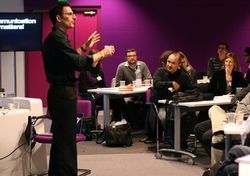
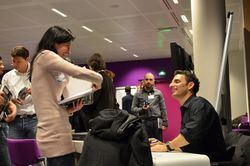
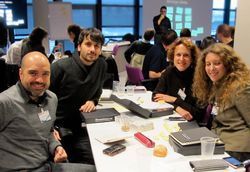
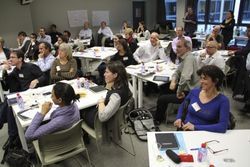
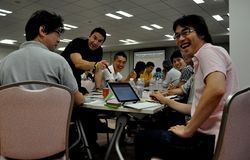
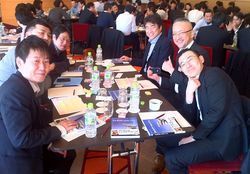
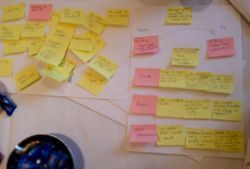
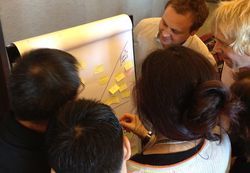
Above: A few snaps from recent Presentation Zen seminars in Paris, Tokyo, and Shanghai. This will be the first PZ seminar series in London (although I have presented several times in London, Oxford, etc.).
Held at the Hilton London Paddington Hotel
The Hilton London Paddington is a classic hotel that is centrally located and has easy access from Heathrow (Paddington Station) and the Eurostar (St Pancras station). Fantastic hotel and a great location.
A couple of testimonials from the Paris seminars in previous years
"It
truly was an excellent workshop and an engaging experience. These are
best practices for effective communication across a variety of media. It
cannot be hammered home enough just how important these concepts are to
effective communication, whoever you are and whatever your personal or
professional goals. A big thanks to Garr Reynolds for sharing his
energy, talent, and knowledge and to the gracious, generous organizers
for what I wholeheartedly agree was a first-class event."
— Sara Freitas-Maltaverne, Director, SFM Traduction, France
"Garr's
seminars in Paris were the rare opportunity to see him live in Europe
and take an active part in the Presentation Zen movement. His
presentation skills are outstanding and his message is simple yet
powerful. Meeting other interested and interesting presenters helped me
to gain a new perspective on presentations."
— Boris Baesler, Presentation Coach, Switzerland
More information about the Presentation European Seminars 2012.
東京 Nikkei Seminar 10月4日
日
本の皆さんも、オリンピックの熱気が冷めやらぬロンドンでのトレーニングに参加しませんか?今のところ、日本を含む15の国から参加者が集ってきていま
す。ロンドンが無理なら、10月4日に東京で開催される1日集中セミナーにぜひご参加ください。ロンドンでも東京でも(もちろん両方でも!)、皆さんにお
会いできるのを楽しみにしています。
• プレゼンテーションZen 第2版 Now on Sale!



September 19, 2012
TEDxKyoto held Sept 16 (Update: videos now live)
 The first big TEDxKyoto will be held this Sunday, Sept 16 in the beautiful and historic city of Kyoto, Japan. Years of preparation and planning have gone in to this event and the organizers have worked very hard to put on a first class TEDx conference. Most of the presentations will be in Japanese (with interpretation) and there are a great list of speakers from all over Japan and the world. A few presentations will be in English, including mine which is schedule near the end of the day. I'll be speaking for about 15 min on the impact of visuals, video, and story in short-form presentations today.
You can follow the event live on ustream.
The videos will be on line in HD soon after the event. Below is a teaser for the event in video form. And if you are attending the event live in Kyoto, I look forward to seeing you there.
The first big TEDxKyoto will be held this Sunday, Sept 16 in the beautiful and historic city of Kyoto, Japan. Years of preparation and planning have gone in to this event and the organizers have worked very hard to put on a first class TEDx conference. Most of the presentations will be in Japanese (with interpretation) and there are a great list of speakers from all over Japan and the world. A few presentations will be in English, including mine which is schedule near the end of the day. I'll be speaking for about 15 min on the impact of visuals, video, and story in short-form presentations today.
You can follow the event live on ustream.
The videos will be on line in HD soon after the event. Below is a teaser for the event in video form. And if you are attending the event live in Kyoto, I look forward to seeing you there.Update
We all had a great time at the inaugural TEDxKyoto event Sept 16. The audience was great and full of very interesting creatives and leaders from tech, entertainment, design, education, etc. The after party was fantasticâmet so many cool people. In a few weeks the videos of each speaker/performer will be up on the TEDxKyoto site and on tedxtalks.ted.com Here are a few pics from the event.

Garr Reynolds on stage at TEDxKyoto, Sept 16, 2012.
 Â
 
Left: With Zen Priest Daiko Matsuyama from the Taizon Temple in Kyoto. Meant a lot to have him say how much he appreciated the PZ approach to presentation. Right: With Patrick Newell (co-founder of TEDxTokyo), and Makoto Kyoto (a genuine Geiko or Geisha). Makoto is a jazz singer too â here is her album on Amazon.



September 9, 2012
TEDxKyoto held this Sunday (Sept 16) - watch live!
 The first big TEDxKyoto will be held this Sunday, Sept 16 in the beautiful and historic city of Kyoto, Japan. Years of preparation and planning have gone in to this event and the organizers have worked very hard to put on a first class TEDx conference. Most of the presentations will be in Japanese (with interpretation) and there are a great list of speakers from all over Japan and the world. A few presentations will be in English, including mine which is schedule near the end of the day. I'll be speaking for about 15 min on the impact of visuals, video, and story in short-form presentations today.
You can follow the event live on ustream.
The videos will be on line in HD soon after the event. Below is a teaser for the event in video form. And if you are attending the event live in Kyoto, I look forward to seeing you there.
The first big TEDxKyoto will be held this Sunday, Sept 16 in the beautiful and historic city of Kyoto, Japan. Years of preparation and planning have gone in to this event and the organizers have worked very hard to put on a first class TEDx conference. Most of the presentations will be in Japanese (with interpretation) and there are a great list of speakers from all over Japan and the world. A few presentations will be in English, including mine which is schedule near the end of the day. I'll be speaking for about 15 min on the impact of visuals, video, and story in short-form presentations today.
You can follow the event live on ustream.
The videos will be on line in HD soon after the event. Below is a teaser for the event in video form. And if you are attending the event live in Kyoto, I look forward to seeing you there.


July 26, 2012
Tips on how to be more creative by John Cleese
Assembling talking points, lists, and tedious outlines is a rather drab exercise that neither challenges your creative abilities or leads to a rewarding experience for you or your audience. But if you are going to do something different, if you are going to craft a talk that engages, illuminates, and even inspires, then the preparation is going to take creativity. This is especially true for the creation of a short-form presentation such as a TED/TEDx talk, or an Ignite or Pecha Kucha presentation, etc. In spite of much our formal schooling's efforts to mold us into compliance seekers rather than curious and intelligent creatives, we are still at our core creative beings. Creativity is in all of us—in fact it's who we are. And yet, regardless of our professions, we can benefit greatly from being even more creative. So how to do that? One way to start is to listen to the legendary John Cleese below and incorporate his tips into your daily work and life where possible. This speech is from 1991 and is as relevant as ever.
Can you learn to be more creative?
In case you don't have 30 minutes to watch this video, I have summarized Cleese's thoughts here. Early on Cleese refers to the late UC Berkeley psychologist Donald MacKinnon (1903-1987), who Cleese says, reached many of the same conclusions scientifically that he arrived at over the years through experience. But Cleese also prefaces his speech with the idea that any talk about how to be more creative is futile since it's one of those things that just can't be explained. "It is literally inexplicable," Cleese says, albeit a bit tongue in cheek. Cleese says that while it's difficult to say what creativity is, he can at least shed light on what it is not. "Creativity is not a talent, it is a way of operating," Cleese said. "Creativity is not an ability that you either have or do not have. It is...absolutely unrelated to IQ." Dr. Mackinnon also found that, beyond a certain minimal level of intelligence, creativity and intelligence were not necessarily related. What makes some intelligent people more creative than other intelligent people it seems is that the more creative people are able to get themselves into a particular mood, according to Cleese (and Mackinnon's research). A mood or a state "that allowed their natural creativity to function." Mackinnon described this as an ability to play and even to be childlike. In this state people are able to explore and discover, even though there may not be any immediate practical purpose to their play. "Play for its own sake," Cleese stated, is the key.
Open & closed
Cleese says that we can describe the way people function at work in terms of two basic modes: open and closed — and creativity is not possible in the closed mode. The closed mode is the one we are in most of the time at work, running around busy in an "active...slightly anxious mode." The closed mode is not a bad thing, of course, and is often crucial for getting things done — but it is not creative. By contrast, the open mode, says, Cleese, is more relaxed, less purposeful, more contemplative, and more inclined to humor. "Humor," Cleese says, "always accompanies a wider perspective." The open mode is more playful and curiosity can operate for its own sake since there is less pressure to get to a particular goal quickly. Play, says Cleese, "allows our natural creativity to surface."
Conditions needed to become more creative
Cleese elaborates on five factors that may lead to the open mode and thus at least improve conditions for creativity to flourish. They are Space, Time, Time, Confidence, and Humor. (Not surprisingly, these factors are often lacking in schools due to the regimented, institutional approach to most schooling around the world and the compliance-driven, beauracratic atmosphere that besets many large organizations.)
(1) Space. You can't be playful and creative in your usual environment with its usual pressures, Cleese says, since to cope with all the pressures you need to be in the closed mode. Therefore, you need to create a space which gets you away from the everyday stresses and pressures of your job. It needs to be a kind of fortress of solitude in which you will not be disturbed.
(2) Time. The space you create for yourself must be maintained uninterrupted for a specific amount of time. Cleese suggests 90 minutes as a minimum. It is difficult (impossible?) to get yourself in the open mode by giving yourself space, say, ten minutes here and fifteen minutes there — it doesn't work that way. Without a specific starting and finishing time, it is too easy to drift back into the closed mode of putting out fires and dealing with the everyday stress of reacting to problems.
(3) Time. You have now used space and time to create an oasis of quiet, but it is also key that you not take the easy way out just to get the problem solved. Cleese believes, and Donald MacKinnon reached a similar conclusion, that the more creative people are willing to tolerate the discomfort of not solving the problem quickly in order that they may discover a much better and more original solution. The more creative people, then, put in more pondering time. The aim should be to give yourself the maximum pondering time possible while still being decisive once your solution is reached.
(4) Confidence. To play is to experiment and try new things, and this necessarily leads to making, for a lack of a better term, mistakes. We must remain open to trying anything without fear of it not working out. You cannot be playful if you are frightened of being wrong. "Nothing will stop you being creative so effectively as the fear of making a mistake," Cleese says. You must have the confidence to be free to play. Realizing that there is no such thing as "a mistake" while you are experimenting and pondering in the open mode will help you be more creative.
(5) Humor. Humor gets us from the closed mode to the open mode "faster than anything else," Cleese says. Laughter creates relaxation and humor widens our perspective. The problem is, people confuse serious with solemn. We can be quite serious indeed while still using humor to examine, ponder, and even discuss very import issues. Laughter does not necessarily make what you are working on any less serious. On the other hand, solemnity, says Cleese does nothing more than serve pomposity and egotism of those who are threatened by the freedom and creative thinking that can be generated by humor. "Humor is an essential part of spontaneity, and an essential part of playfulness — an essential part of the creativity that we need to solve problems, no matter how serious they may be."
In the spirt of factor five above, please enjoy this skit called The Argument Clinic from Cleese's early work with Monty Python's Flying Circus in 1972. This is still one of my favorite bits. We used to watch this at our Philosophy Club meetings in my college days at OSU.
Final points
While you are in the open mode, you must keep your mind around your subject, Cleese says. You can daydream, but you need to gently keep bringing your mind back to the problem. "If you just keep your mind resting against the subject in a friendly but persistent way, sooner or later you will get a reward from your unconscious." If you put in the pondering time first, this reward may come as what feels like a sudden insight from nowhere or an epiphany. Cleese says that it can be very rewarding to create a space and time to play with others on a problem as well. However, it is important that your partner or small group members not create an atmosphere that is defensive. In closing Cleese touches on the ideas of random connections and intuition, and the ideas of Edward DeBono and "intermediate impossibles" that lead to more creative thinking. Finally Cleese offers amusing advice on "how to stop your subordinates from being creative."
Recent interview with John Cleese on creativity.
Below Cleese touches on creativity and "slow" and "fast" thinking.
Link
• Presentation: A few minutes with John Cleese on creativity



Garr Reynolds's Blog
- Garr Reynolds's profile
- 107 followers


